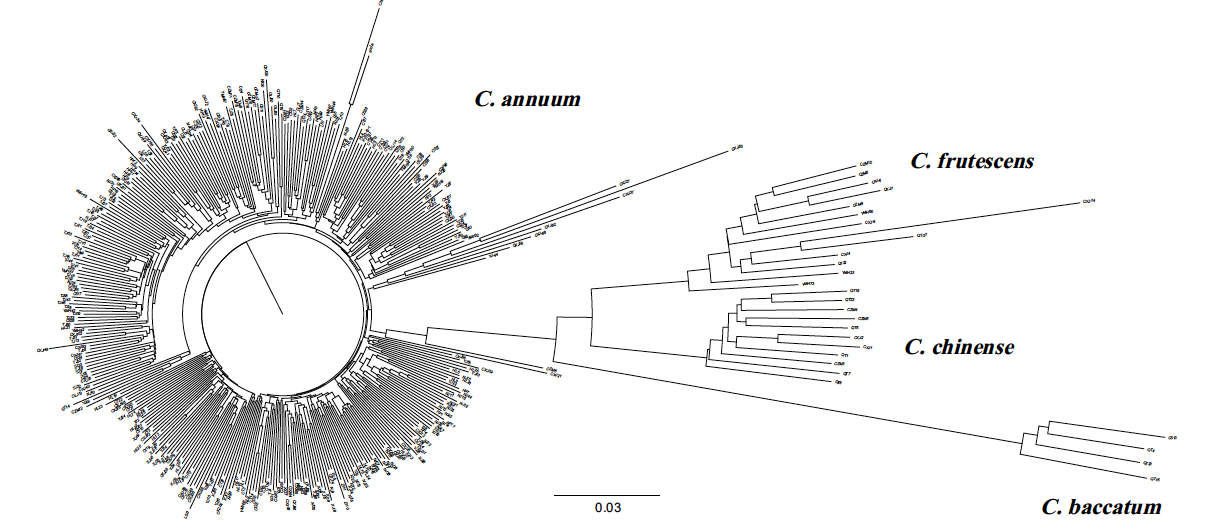博文
New Phytologist:辣椒泛基因组研究(补2018.8.22)
||
Pan‐genome of cultivated pepper (Capsicum) and its use in gene presence-absence variation analyses
First author: Lijun Ou; Affiliations: Hunan Academy of Agricultural Sciences (湖南省农业科学院): Hunan, China
Corresponding author: Xuexiao Zou (邹学校)
Peppers (Capsicum) are a very important agricultural crop worldwide. There are five major cultivated species of Capsicum: C. annuum L., C. frutescens L., C. chinense Jacquin, C. baccatum L. and C. pubescens Ruiz & Pavon (Heiser, 1969). Each of the five cultivated species has 12 chromosomes (Moscone et al., 2007). The genomes of two C. annuum cultivars, Zunla‐1 (Qin et al., 2014) and CM334 (Kim et al., 2014), were first sequenced in 2014. The genomes of C. baccatum PBC81 and C. chinense PI159236 were also sequenced and reported recently (Kim et al., 2017). According to these studies, the genome sizes of these pepper species vary between 3.2 and 3.9 Gb, nearly 80% of which consists of repetitive regions. To explore genetic variability and diversity that exist within a species, pan‐genome studies have been recently reported for some important crop plants, including corn, soybean, rice, and wheat (Golicz et al., 2016; Montenegro et al., 2017). These plant pan‐genome studies have shown that significant gene presence-absence variations (PAVs) within a species can contribute to trait variation. For this reason, we constructed and annotated the first pepper pan‐genome. Given that pepper genomes are highly repetitive, leading to the potential false identification of single nucleotide polymorphisms (SNPs), we used the gene PAV approaches for our phylogenetic analysis and a genome‐wide association study (GWAS), instead of using SNPs. Using results of the read coverage for genes, we also identified genetic variations in some key genes involved in the biosynthetic pathways of capsaicinoids and carotenoids which are two of the distinctive traits in the pepper plants compared with other crops. We have also created a website to provide access to the pepper pan‐genome data.
辣椒是全球范围内比较重要的农作物,主要有5个栽培种:一年生辣椒、小米椒、黄灯笼辣椒、风铃辣椒和茸毛辣椒。这五大栽培种辣椒均有12条染色体。一年生辣椒栽培品种Zunla‐1和CM334在2014年完成测序。风铃辣椒栽培品种PBC81和黄灯笼辣椒栽培品种PI159236已经也已经完成测序。这些研究显示辣椒不同栽培种基因组大小的变异宅3.2~3.9 Gb之间,其中约有80%的基因组区域为重复序列。为了研究种内遗传变异与多样性,进来的一些研究团队对一些重要的的作物品种开展了泛基因组研究,其中包括玉米、大豆、水稻及小麦。这些物种的泛基因组研究显示物种内的基因存在-缺失变异(presence-absence variation;PAV)影响了不同栽培种之间的性状差异。因此,本文报道了第一个辣椒的泛基因组研究。辣椒基因组的高度重复特性导致单核苷酸多态性SNP的鉴定存在潜在的错误,因此作者在进化分析和全基因组关联分析时并未基于SNP的数据,而是采用了PAV的结果。利用基因上read的覆盖度信息,作者还鉴定了辣椒素和类胡萝卜素这两个辣椒区别于其它作物最重要的化合物的生物合成通路关键基因的遗传变异。作者还构建了一个在线网站以方便全球的研究者获取有关辣椒泛基因组的数据。
通讯:邹学校 (http://www.hunaas.cn/shownews.asp?nid=3439)
个人简介:1983年,湖南农业大学,蔬菜学士;2005年,南京农业大学,农学博士。
研究方向:辣椒种质资源收集与保存;辣椒新品种培育。
doi: https://doi.org/10.1111/nph.15413
Journal: New Phytologist
First Published: 21 August, 2018
(P.S. 原文下载:链接:https://pan.baidu.com/s/1qFiSsqwlF_7JjmGMbedfhQ 密码:dmu6)
https://blog.sciencenet.cn/blog-3158122-1130735.html
上一篇:Genome Biology:TE对于六倍体小麦基因结构和演化的影响
下一篇:Plant Physiology:玉米ZmbZIP4作用于非生物胁迫抗性与根发育
全部作者的其他最新博文
- • Plant Physiology:CsMADS3促进柑果中的叶绿素降解和类胡萝卜素合成(华中农业大学)
- • Molecular Plant:LBD11-ROS反馈调节作用于拟南芥的维管形成层增殖和次生生长(浦项科技大学)
- • Science Advances:根结线虫通过调控植物的CLE3-CLV1模块,促进侵染进程(日本熊本大学)
- • Nature Communications:油菜素内酯参与植物营养生长期转变的分子机制解析(浙江农林大学)
- • Current Biology:光合作用产生的蔗糖驱动侧根“生物钟”(德国弗莱堡大学)
- • PNAS:花同源异型基因在叶中被抑制、花中被激活的分子机制(南卡罗来纳大学)

